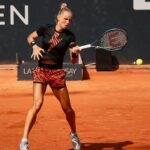Why Novak Djokovic fell short in Calendar Slam quest, and what it means – Match Points #33
Novak Djokovic’s run at the Calendar Slam has fallen short, and in the latest edition of Match Points, Marion Bartoli, Carole Bouchard and Simon look at what went wrong and what it means for the world No.1 going forward.
The 2021 Grand Slam season is done and dusted and the Match Points panel – consisting of Marion Bartoli, Carole Bouchard and Simon Cambers – is here to take a closer look at where things went south for Novak Djokovic. The Serbian fell at the last hurdle in his quest to become the first male to lock down the Calendar Year Grand Slam since Rode Laver in 1969.
What went wrong for Djokovic and why wasn’t the 20-time major champion able to complete the mission? Host Josh Cohen guides the panel through an in-depth discussion at the major talking points.
Why was Dokovic unable to complete the mission in NY?
Djokovic headed into the Sunday’s US Open final with a 27-0 record at the Grand Slams in 2021 as well as a 2-0 record against Medvedev at the Grand Slam level. Was it a case of Medvedev being too good or was Djokovic his own worst enemy?
“It was quite obvious,” says Bartoli. “It was just the pressure. It was the same for Serena when she tried it, obviously it was one match earlier [at the 2015 US Open], when she lost in the semifinal to Roberto Vinci and no one expected that result. But for Novak, you can tell, and he said it himself, that he had no legs when he played that final. It was just not the Novak Djokovic that we’re used to seeing. … as much as he’s a superhuman, at some point it was too much, even for him.”
Though Djokovic didn’t do himself any favors by spending far too much time on court during his first six matches in New York, Bouchard argues that Medvedev took matters into his own hands as well.
“I think it’s a case of the worst-case scenario happening,” says Bouchard. “The pressure, and Daniil Medvedev is not that much of a good matchup for him. The guy was playing amazing tennis since Cincinnati and Canada, you could see his time was coming.”
Nobody denies that the loss wasn’t a disappointing one for the world No.1. Just don’t confuse Djokovic falling in his quest to win the Grand Slam with failure.
“It’s not a failure, it’s an amazing achievement. He lacked the last step, but even being there, to try to get the last step, it’s actually amazing,” says Bouchard.
Cambers agrees:
“You have to remember that Djokovic was one win away from completing the Calendar Year Grand Slam at the age of 34, which is nuts,” he says.
Will Djokovic ever reach the Calendar Slam, and how many more Slams will Djokovic win?
Cohen polled the guests, asking them to predict the future for Djokovic. It will be interesting to see if the 34-year-old can turn the corner and continue to dominate at the majors in 2022. Cohen wanted to know two things: Will Djokovic ever take another run at the Calendar Year Grand Slam, and how many Slams will he finish his career with.
Cambers doesn’t see a run at the Calendar Slam happening any time soon. But he does believe Novak has a few more major titles coming. “No to the first one, it’s virtually impossible to complete the calendar year as we’ve seen,” he said. “I think he’s got one or two at least. I’d give him two more.”
Bartoli thinks the world-beating Djokovic will tie Serena Williams on the all-time list.
“I think the Calendar Year Grand Slam will be very difficult but I think Novak will get to 23,” she said.
Bouchard wasn’t ready to rule anything out when it comes to Djokovic. She’s seen the Serb produce too much magic over the last ten years. “I want to say no [about the Calendar Slam], but I should know better with him, so you never know, and the Grand Slam totals, I think in his mind he wants 25, but can he get to 25? That would be crazy. I would think three more.”
Toilet Breaks: Something needs to change
Bathroom breaks were all the rage during week one of the 2021 US Open, and our panel wanted to offer some potential solutions to an issue that caused problems for Stefanos Tsitsipas in New York, and threatens to undermine the integrity of the sport down the road.
Bartoli believes it is difficult to put one all-encompassing time limit on bathroom breaks, because the location of toilets is at varying distances from the many courts in use at tournaments. She thinks the clock should start running as soon as the player arrives at the bathroom.
“It’s very difficult to put a time limit,” Bartoli says. “It has to be a timing when they arrive at the location, it has to be done in three minutes. Of course it will be longer on the outside courts to get to that spot, but at least it gives you some sort of regulation because otherwise it becomes really annoying for everybody, annoying for the TV, annoying for the people in the stadium and annoying for the players as well.”
Cambers believes a fixed rule needs to be added.
“Without a doubt there needs to be a fixed rule, because the players are just moving everything within the rules that are there at the moment, which are so grey and so open to abuse,” Cambers said. “I’m pretty sure something will happen soon, because they can’t let this go on, it can’t be a factor [in the outcome of matches].”
Will the Laver Cup survive in a post Big-3 world?
Last but not least the conversation turns to next week’s Laver Cup. With the big picture in mind, the panel wonders if the event will remain viable now that the Big Three’s days are numbered.
All three guests agreed that the Laver Cup would be better off taking a page from the Hopman Cup’s playbook. Get the women into the event, they say.
“I think it would be great to incorporate women, I think it would be nice to be a mixed event, especially now when you have Leylah playing for the rest of the world, and Emma Raducanu playing for Europe,” Bartoli says. “I think it would be so interesting to see some mixed doubles between Emma and Novak against Leylah and Felix, for example, that would be something a lot of people would pay [to see].”
“I think the only way to go is to go mixed,” Bouchard adds “We need to get men and women together on this, it will be the only thing that makes Laver Cup different than the rest of the tour.”











